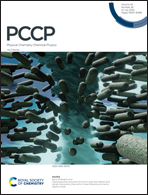Role of ergodicity, aging, and Gaussianity in resolving the origins of biomolecule subdiffusion†
Abstract
The internal motions of biomolecules are essential to their function. Although biological macromolecules conventionally show subdiffusive dynamics, only recently has subdiffusion been associated with non-ergodicity. These findings have stimulated new questions in biophysics and statistical mechanics. Is non-ergodic subdiffusion a general strategy shared by biomolecules? What underlying mechanisms are responsible for it? Here, we performed extensive molecular dynamics (MD) simulations to characterize the internal dynamics of six different biomolecules, ranging from single or double-stranded DNA, a single domain protein (KRAS), two globular proteins (PGK and SHP2), to an intrinsically disordered protein (SNAP-25). We found that the subdiffusive behavior of these biomolecules falls into two classes. The internal motion of the first three cases is ergodic subdiffusion and can be interpreted by fractional Brownian motion (FBM), while the latter three cases involve non-ergodic subdiffusion and can be modeled by mixed origins of continuous-time random walk (CTRW) and FBM.



 Please wait while we load your content...
Please wait while we load your content...